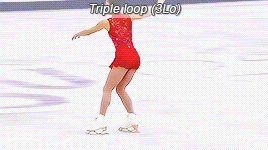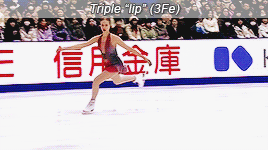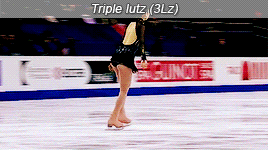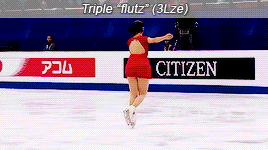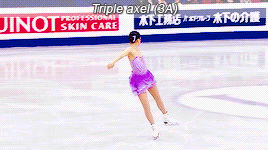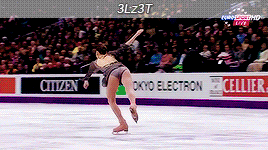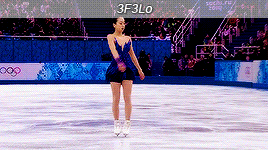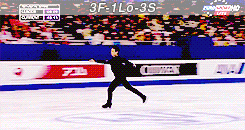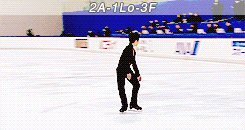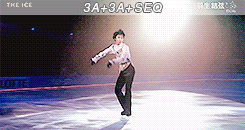
Introduction to Jumps in Singles Skating
Introduction to Jumps in Singles Skating
Welcome to our basic introduction to jumps in figure skating!
More intro to skating guides are available here. Please do not reproduce any part of this post without permission.
LAST UPDATED: Sept 4, 2022
TYPES OF JUMPS
There are six main types of jumps allowed in ISU competitions: toe loop, flip, lutz, salchow, loop, and axel. The toe loop, flip, and lutz are toe jumps - skaters launch into the air with assistance from the toepick (jagged ridges on the toe end of the skate blade) of their free foot. The salchow, loop, and axel are edge jumps - no toepick assistance; skaters take off from the edge of the blade alone.
A skate blade has two edges: the outside edge and the inside edge. Inside edges face each other when the skater is standing on two feet; outside edges face away from each other. All jumps land backwards, usually on an outside edge. Most skaters rotate counterclockwise and land on their right foot; some skaters rotate clockwise and land on their left foot. Clockwise jumps work the same way as counterclockwise jumps, only "left" and "right" are reversed. Since the landing position is always the same, jumps are differentiated by their takeoffs. All jumps have a backwards takeoff except for the axel.
Each type of jump is worth a different amount of points. For jumps with the same number of rotations, the value from least to greatest is: toe loop, salchow, loop, flip, lutz, axel.
———
TOE LOOP (T)
Gabrielle Daleman is a counterclockwise jumper. The toe loop takes off from the outside edge of her right foot. She taps her left toepick into the ice in order to launch into the air, and lands on the outside edge of her right foot.
———
SALCHOW (S)
Kaori Sakamoto is a counterclockwise jumper. The salchow takes off from the inside edge of her left foot and lands on the outside edge of her right foot, with no toepick assistance on takeoff. Salchows are characterized by a “sweeping” motion, and momentarily cause the skater’s legs to take a “knock-kneed” position, with the lower legs splayed apart.
———
LOOP (Lo)
Mirai Nagasu is a counterclockwise jumper. The loop takes off from the outside edge of her right foot and lands on the outside edge of her right foot, with no toepick assistance on takeoff. Notice how her legs appear to be crossed during the setup; this is the easiest way to identify a loop. Mirai also performs a turn into the loop, a common entry.
———
FLIP (F)
Carolina Kostner is a clockwise jumper. The flip takes off from the inside edge of her right foot and lands on the outside edge of her left foot. (For counterclockwise jumpers, this would be reversed.) Notice how she turns from going forwards to backwards on her right foot before tapping into the ice with her left toepick to take off; this turn is a common entry into the flip.
Some skaters have indistinct edges on their flips and lutzes. A “lip” is a flip jump that takes off from an outside edge instead of an inside edge. Anna Pogorilaya, a counterclockwise jumper, turns on her left foot to enter the flip, and taps into the ice with her right toepick in order to take off. However, at the moment of takeoff, her left blade is on the outside edge instead of the inside edge. If the technical panel decides to give a skater a “wrong edge call” (e) on a flip or lutz, the base value of the jump will be reduced and the jump will receive negative Grades of Execution.
———
LUTZ (Lz)
Yuna Kim is a counterclockwise jumper. The lutz takes off from the outside edge of her left foot and lands on the outside edge of her right foot. Her right toepick is used to launch into the air. One way to differentiate between the flip and the lutz if you can’t see the edge clearly is the setup - skaters often glide in a straight line on one foot while entering the lutz, and do a turn into the flip.
The lutz is unique in that it causes counterrotation during the setup - gliding backwards on a left outside edge will tend to make the skater's body curve to the left, but if they are a counterclockwise jumper, their body naturally rotates to the right. This counterrotation is one of the reasons why the lutz is a difficult jump for some skaters.
A “flutz” is a lutz jump that takes off from an inside edge instead of an outside edge. Kaori Sakamoto, a counterclockwise jumper, sets up the lutz on her left foot, and taps into the ice with her right toepick in order to take off. However, at the moment of takeoff, her left blade is on the inside edge instead of the outside edge. If the technical panel decides to give a skater a “wrong edge call” (e) on a flip or lutz, the base value of the jump will be reduced and the jump will receive negative Grades of Execution.
———
AXEL (A)
The axel is easy to distinguish from the other jumps as it is the only one with a forward takeoff. Mao Asada, a counterclockwise jumper, takes off from the outside edge of her left foot and lands on the outside edge of her right foot. Due to its forward takeoff, an axel has half a rotation more than other jumps with the same “number” of rotations. Triple axels are more common in men’s skating than women’s skating.
COMBINATIONS AND SEQUENCES
In a jump combination, the landing edge of one jump is the takeoff edge of the next jump. The first jump in a combo can be any of the six types of jumps. Since jumps usually land backwards on an outside edge, the second jump in a combo is usually a toe loop or a loop, since those two jumps take off from a backwards outside edge. In triple-triple combinations in particular, the second jump is often a toe loop because it is difficult to fully rotate a triple loop on the back end of a combo.
In singles and pairs' free skates, a combo can have up to three jumps. The base value of a combo is the sum of the base values of the jumps in the combo.
Here is Yuna Kim performing a 3Lz+3T combo. After landing the lutz, her free leg swings back to tap her toepick into the ice in order to take off for the toe loop.
Here is Mao Asada performing a 3F+3Lo combo. After landing the flip, she takes off immediately from the back outside edge for the loop, with no toepick assistance.
(For more 3-3 combos, see this post.)
Since the 2012-13 season, skaters are allowed to do an Euler (formerly called half loop), a non-standard jump, after their first jump in a combo in order to "switch feet" and do a salchow or flip in the second half of the combo. Eulers appear as 1Eu in protocols and have their own base value. Euler combos are considered 3-jump combos.
Here is Denis Ten performing a 3F+1Eu+3S combo. After landing the flip, he "switches feet" with the Euler and takes off from his left inside edge for the salchow with no toepick assistance.
Here is Shoma Uno performing a 2A+1Eu+3F combo. After landing the axel, he "switches feet" with the Euler and takes off from his left inside edge, while using his right toepick to launch.
In a jump sequence, the second jump does not take off from the landing edge of the first jump. Skaters do a small step in between the jumps of a sequence while still maintaining flow between the jumps. Since the 2018-19 season, only axels are allowed as the second jump in a jump sequence. Starting from the 2022-23 season, the base value of jump sequences is the sum of the base values of the jumps in the sequence. (Formerly, the base value was 80% of the sum.)
Here is Elizaveta Tuktamysheva performing a 3S+2A sequence:
And finally, here is Yuzuru Hanyu performing a 3A+3A sequence:


